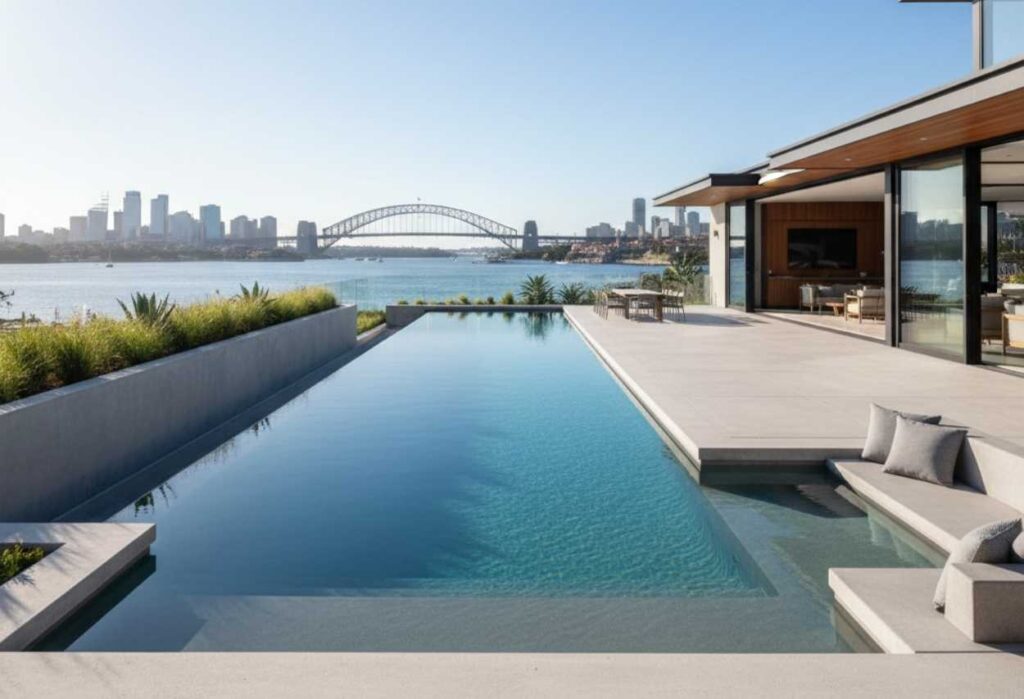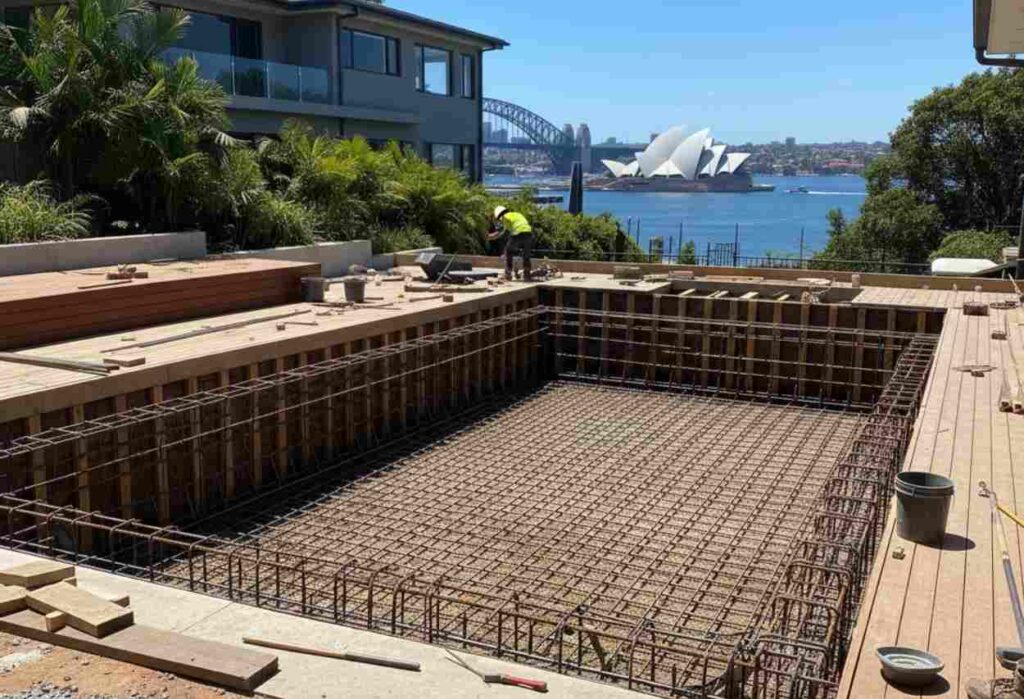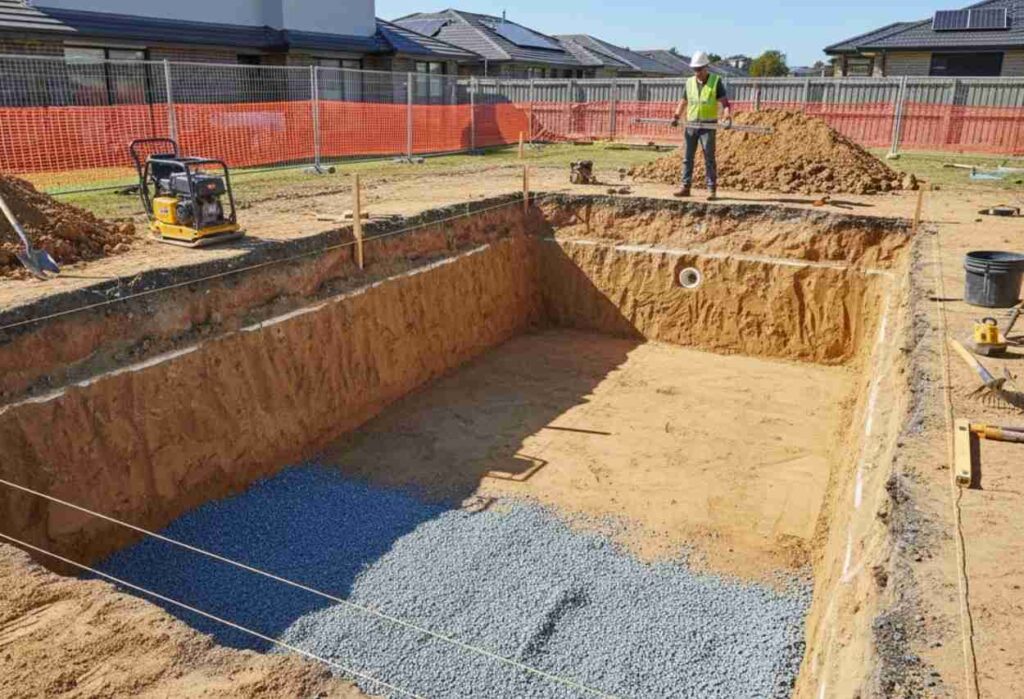At Plunge Pools Sydney, we combine rebar strength with proper soil work so your pool stays safe and stable in Sydney’s conditions.
This article explains why rebar and soil prep are critical, how they work together, and how they help homeowners enjoy their pools without costly surprises.
Table of Contents
ToggleThe Problem with Large Concrete Pools

The biggest issue with large concrete pools is pressure. More water means more stress on the pool shell and the soil below, which raises the risk of cracks, leaks, and shifting. Without proper reinforcement, repairs can run into tens of thousands of dollars.
Large concrete pools hold far more water than small plunge pools or fibreglass shells. That added volume increases structural stress, both on the concrete itself and on the soil foundation. When the soil struggles to carry the load, or when water pushes against the pool walls (called hydrostatic pressure), the risk of damage rises sharply.
Typical problems include:
- Cracking in the shell caused by uneven soil movement or water stress.
- Leaks that spread through weak joints and concrete gaps.
- Shifting foundations when soil isn’t compacted or stable.
- Rising maintenance costs, since small issues quickly grow more expensive to fix.
In short, a large pool may look strong when first built, but without the right rebar and soil preparation, small weaknesses can turn into major structural problems over time.
Why Is Rebar Important in Concrete Pools?

Rebar, or steel reinforcement bars, stops a concrete pool from cracking under water pressure. It adds tensile strength, spreads the load, and keeps the pool shell intact for decades.
Concrete is strong when squeezed (compression) but weak when pulled (tension). That’s why rebar, short for reinforcing bar, is essential in every large swimming pool. Rebar acts like the hidden skeleton inside the shell, giving the pool extra strength where concrete alone would fail.
Here’s how rebar protects a pool:
- Spreads the load – Water pressure is shared across the steel, so no single part of the shell takes all the force.
- Stops cracks forming – Rebar adds tensile strength, which concrete lacks, reducing the chance of splitting or breaking apart.
- Correct spacing matters – Rebar must be placed at the right distance apart to avoid weak spots that can lead to fractures.
- Rust protection – If rebar corrodes, it expands and breaks the concrete around it. Waterproofing and proper concrete cover prevent this.
A poorly reinforced pool may look fine at first but can fail within a few years. In contrast, a pool built with correctly designed rebar reinforcement can stay stable and safe for 30 years or more.
Why Is Soil Preparation Important for Concrete Pools?

Soil preparation makes sure the ground under your pool can hold its weight. In Sydney, clay expands and sandy soils erode, so proper compaction and drainage are critical to prevent cracks and leaks.
A swimming pool is only as strong as the ground it sits on. Even with reinforced concrete, if the soil beneath shifts, the pool shell can crack, leak, or sink. That’s why soil preparation is a crucial step before construction begins.
Key parts of soil preparation include:
- Soil compaction – Compressing the ground so it can safely carry the pool’s weight without settling.
- Load-bearing tests – Checking that the soil has enough strength to hold a large pool for decades.
- Managing Sydney’s soil challenges – Clay swells and shrinks with moisture, while sandy soil can wash away. Both need extra care.
- Drainage planning – Installing systems to relieve hydrostatic pressure, which happens when groundwater pushes up against the pool base.
Skipping or rushing this step is one of the main reasons pools develop structural problems. With the right preparation, the soil stays stable and supports the pool for many years, reducing costly repairs.
How Do Rebar and Soil Preparation Work Together in Concrete Pools?
Rebar and soil preparation work together: soil keeps the base stable, while rebar stops the pool shell from cracking. Together, they create a strong structure that can last for decades.
Rebar and soil preparation are not separate steps, they rely on each other to make a pool safe and durable.
- Concrete handles compression: It resists downward weight from water and soil.
- Rebar resists tension: It prevents the shell from splitting when water pressure pushes outwards or when the soil shifts.
- Soil provides the foundation: Properly compacted ground reduces movement that causes cracks and leaks.
- Working together: Stable soil lowers stress on the shell, and reinforced steel spreads the load, creating a balanced system that holds up for decades.
In Sydney, where clay soils expand and contract and coastal sands can erode, this partnership is especially important. A concrete pool built without attention to both rebar and soil often develops costly structural issues within a few years, while one built with both can last generations.
What Are the Long-Term Benefits of Rebar and Soil Preparation in Concrete Pools?
The benefits of rebar and soil preparation are simple: stronger pools, fewer repairs, higher home value, and finishes that last longer.
Investing in rebar and soil preparation during construction pays off for homeowners in the years ahead. These measures reduce hidden risks and protect your investment long-term.
Key benefits include:
- Stronger, safer pools – Reinforced shells and stable soil foundations stop cracks and leaks before they start.
- Lower repair bills – With fewer structural problems, you save money on maintenance and costly fixes.
- Premium finishes that last – Tiles, coping, and decorative edges stay intact longer when the pool base is stable.
- Higher property value – Buyers are more attracted to homes with well-built swimming pools backed by engineering.
- Peace of mind – Knowing your pool is built to withstand Sydney’s tough soil and weather conditions makes ownership stress-free.
In short, proper reinforcement and soil preparation make a large concrete pool not just a luxury feature, but a smart and cost-effective investment.
What’s the Difference Between Concrete Pools and Fibreglass Pools?
Large concrete pools need rebar and soil preparation because they’re heavy and rigid. Fibreglass pools are lighter and more flexible but limited in size.
Homeowners often compare concrete and fibreglass when deciding on a pool. Both materials work well, but they perform very differently:
- Concrete pools – Strong, heavy, and fully customisable. They can be built in almost any shape or size. But because they are rigid, they can’t flex with soil movement, which is why rebar reinforcement and soil preparation are non-negotiable.
- Fibreglass pools – Lighter and factory-moulded. The shell has a natural flexibility, which makes it more forgiving in soils that shift. However, fibreglass pools are limited in size and shape, and they don’t suit very large projects.
- Cost trade-off – Fibreglass pools are usually cheaper upfront, but reinforced concrete pools, when built correctly, offer longer lifespans and higher property value.
For Sydney homeowners who want a large pool built to last, concrete with proper engineering remains the stronger choice. Fibreglass can be ideal for smaller, simpler installs where flexibility matters more than scale.
What Are the Risks of Building a Pool Without Proper Reinforcement?
Without rebar and soil preparation, pools often crack within 5–10 years, face insurance issues, and in extreme cases can even collapse.
Skipping reinforcement or soil preparation during construction is one of the costliest mistakes a homeowner or builder can make. A pool might look solid at first, but hidden weaknesses show up fast once the structure is filled with water.
Common risks include:
- Early structural damage – Cracks, leaks, and shell movement can appear within the first decade.
- Insurance problems – Many policies deny claims if the failure is linked to poor engineering or skipped preparation.
- Expensive repairs – Fixing structural faults can cost tens of thousands and often requires partial reconstruction.
- Safety hazards – In rare cases, severe soil shifting or concrete failure can lead to partial collapse.
For large concrete pools, cutting corners on reinforcement is never worth the short-term savings. Proper rebar design and soil testing protect both your pool and your investment.
Case Example: Sydney Clay Soil Project
One Sydney homeowner learned the hard way what happens when soil preparation and rebar spacing are overlooked. Their large concrete pool, built on reactive clay, developed deep cracks within just three years. The repair bill came to more than $40,000.
By contrast, a neighbouring property with the same type of soil took the right approach. Their pool was reinforced with properly spaced rebar and built on compacted, stabilised soil. Fifteen years later, the pool is still in excellent condition, with only routine maintenance needed.
This comparison shows the difference between cutting corners and investing in the right engineering from the start.
Why Do Concrete Pools Fail Even with Rebar?
Concrete pools can still fail if the rebar or soil preparation is done incorrectly. Common mistakes include short lap lengths, too little cover over rebar, and missed soil compaction.
Even when a builder includes rebar, poor workmanship or skipped details can shorten the lifespan of a pool. Concrete, steel, and soil must all work together — if one step is wrong, the structure is at risk.
Typical reasons pools still fail include:
- Short lap lengths – If reinforcing bars don’t overlap enough, the joints are weak and prone to cracking.
- Insufficient concrete cover – Rebar needs enough concrete around it to stay protected. Too little cover lets moisture in, which causes rust and expansion.
- Missed soil compaction – Without compacted soil, the base shifts unevenly, creating stress points in the pool shell.
- Inconsistent spacing – Steel placed too far apart creates weak zones that can’t handle pressure.
These details may seem small, but each one can trigger major problems over time. Correct engineering and careful checks during construction ensure rebar does its job properly.
How Can Modern Engineering Future-Proof Concrete Pools?
Modern engineering extends the life of concrete pools with epoxy-coated rebar, soil stabilisation, and advanced drainage systems that prevent corrosion, shifting, and water pressure damage.
Today’s best builders use more than just standard concrete and steel. They apply advanced materials and engineering methods to protect pools from Sydney’s challenging soils and harsh climate.
Key techniques include:
- Epoxy-coated rebar – A protective layer stops steel from rusting, especially in saltwater pools where corrosion is common.
- Geotextile soil stabilisation – Special fabrics strengthen and stabilise weak soils, reducing shifting over time.
- Advanced drainage systems – Properly designed drains relieve hydrostatic pressure, stopping water from pushing up against the base of the pool.
- Improved waterproofing membranes – Extra barriers keep both soil moisture and pool water from damaging the shell.
By combining these modern practices, builders create pools with longer lifespans, lower maintenance costs, and fewer risks of structural damage. Homeowners get peace of mind knowing their pool is engineered to last decades.
Builder Questions Every Homeowner Should Ask
Before you sign a pool contract, it’s important to know how your builder handles reinforcement and soil work. Asking the right questions protects you from poor workmanship and hidden costs later.
Here are the most important ones to ask:
- Do you provide structural certification for rebar?
– Certification from an engineer confirms that reinforcement meets Australian standards. - How do you prepare soil on clay or coastal sites?
– Builders should explain how they compact, stabilise, and drain different soil types common in Sydney. - What warranties cover cracks and leaks?
– A strong warranty should cover structural issues, not just surface finishes. - Do you use independent engineers for soil testing?
– Third-party testing adds another layer of trust and prevents shortcuts. - What corrosion protection do you use on rebar?
– Look for epoxy-coated or well-covered steel to stop rust before it starts. - Can I see past projects with similar soil conditions?
– References from homeowners with clay or sandy sites give real-world proof of reliability.
Asking these questions upfront helps you separate experienced builders from those who cut corners. The answers also give you confidence that your investment is backed by sound engineering.
How to Compare Builder Proposals
Choosing a pool builder isn’t just about the quote. Two proposals may look similar in price, but the details inside will reveal who is offering real long-term value.
When reviewing proposals, check carefully for:
- Soil test results – Every site is different. A proper builder will include soil analysis specific to your property, not a generic assumption.
- Engineering reports – Look for clear reinforcement plans showing rebar placement, lap lengths, and cover requirements. These documents prove the design is backed by structural engineering.
- Warranty coverage – A strong warranty should spell out what happens if cracks, leaks, or soil issues occur. Avoid vague wording or short coverage periods.
- Drainage and waterproofing details – Confirm how the builder plans to manage groundwater, stormwater, and pool waterproofing. These details prevent costly failures later.
- Materials and finishes – Compare the type of rebar, concrete strength, and finishing options. Premium materials reduce maintenance costs over time.
- Value beyond cost – Some builders include independent inspections, site supervision, or longer warranties in their price. These extras often mean better quality control.
By focusing on engineering quality, soil preparation, and clear warranties, you can separate a reliable proposal from one that cuts corners. The best value is the pool that stays safe and durable for decades, not just the cheapest price on paper.
Conclusion
Large concrete pools need rebar and soil preparation to stay strong for decades. At Plunge Pools Sydney, we engineer pools that resist cracks, leaks, and costly failures, so your pool is an asset, not a liability.
Contact us today to build a pool that’s safe, strong, and future-proof.
FAQs
Why is rebar necessary in swimming pools?
Rebar prevents cracks by giving concrete the tensile strength it lacks. In large swimming pools, rebar distributes water pressure across the shell, making the structure safer and more durable.
What happens if soil isn’t compacted before building a pool?
Without compaction, soil can shift under the pool, causing cracks, leaks, or uneven settlement. Proper soil preparation ensures stability and reduces long-term repair risks.
Is epoxy-coated rebar worth the extra cost?
Yes, epoxy-coated rebar is more resistant to corrosion, especially in saltwater pools. While it costs more upfront, it extends the life of the swimming pool and lowers future maintenance costs.
How long should a reinforced concrete pool last?
A reinforced concrete pool built with proper rebar and soil preparation can last 30 years or more. Regular maintenance and quality waterproofing help extend the lifespan even further. Choosing an experienced Sydney builder ensures maximum durability.
Can rebar rust inside a pool shell?
Yes, rebar can rust if it isn’t covered with enough concrete or if waterproofing fails. When steel corrodes, it expands and causes cracking. Using epoxy-coated rebar and correct cover depth prevents this problem.




